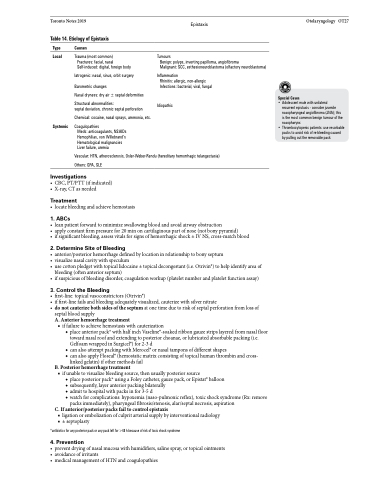Page 1013 - TNFlipTest
P. 1013
Toronto Notes 2019
Epistaxis
Otolaryngology OT27
Table 14. Etiology of Epistaxis
Type
Local
Systemic
Causes
Trauma (most common)
Fractures: facial, nasal Self-induced: digital, foreign body
Iatrogenic: nasal, sinus, orbit surgery
Barometric changes
Nasal dryness: dry air ± septal deformities
Structural abnormalities:
septal deviation, chronic septal perforation
Chemical: cocaine, nasal sprays, ammonia, etc.
Coagulopathies
Meds: anticoagulants, NSAIDs Hemophilias, von Willebrand’s Hematological malignancies Liver failure, uremia
Vascular: HTN, atherosclerosis, Osler-Weber-Rendu (hereditary hemorrhagic telangectasia) Others: GPA, SLE
Tumours
Benign: polyps, inverting papilloma, angiofibroma
Malignant: SCC, esthesioneuroblastoma (olfactory neuroblastoma)
Inflammation
Rhinitis: allergic, non-allergic Infections: bacterial, viral, fungal
Idiopathic
Special Cases
• Adolescent male with unilateral
recurrent epistaxis - consider juvenile nasopharyngeal angiofibroma (JNA); this is the most common benign tumour of the nasopharynx
• Thrombocytopenic patients: use resorbable packs to avoid risk of re-bleeding caused by pulling out the removable pack
Investigations
• CBC,PT/PTT(ifindicated) • X-ray,CTasneeded
Treatment
• locatebleedingandachievehemostasis
1 . ABCs
• leanpatientforwardtominimizeswallowingbloodandavoidairwayobstruction
• applyconstantfirmpressurefor20minoncartilaginouspartofnose(notbonypyramid)
• ifsignificantbleeding,assessvitalsforsignsofhemorrhagicshock±IVNS,cross-matchblood
2 . Determine Site of Bleeding
• anterior/posteriorhemorrhagedefinedbylocationinrelationshiptobonyseptum
• visualizenasalcavitywithspeculum
• usecottonpledgetwithtopicallidocaine±topicaldecongestant(i.e.Otrivin®)tohelpidentifyareaof
bleeding (often anterior septum)
• ifsuspiciousofbleedingdisorder,coagulationworkup(plateletnumberandplateletfunctionassay)
3 . Control the Bleeding
• first-line:topicalvasoconstrictors(Otrivin®)
• iffirst-linefailsandbleedingadequatelyvisualized,cauterizewithsilvernitrate
• donotcauterizebothsidesoftheseptumatonetimeduetoriskofseptalperforationfromlossof
septal blood supply
A. Anterior hemorrhage treatment
■ if failure to achieve hemostasis with cauterization
◆ place anterior pack* with half inch Vaseline®-soaked ribbon gauze strips layered from nasal floor
toward nasal roof and extending to posterior choanae, or lubricated absorbable packing (i.e.
Gelfoam wrapped in Surgicel®) for 2-3 d
◆ can also attempt packing with Merocel® or nasal tampons of different shapes
◆ can also apply Floseal® (hemostatic matrix consisting of topical human thrombin and cross-
linked gelatin) if other methods fail
B. Posterior hemorrhage treatment
■ if unable to visualize bleeding source, then usually posterior source
◆ place posterior pack* using a Foley catheter, gauze pack, or Epistat® balloon
◆ subsequently, layer anterior packing bilaterally
◆ admit to hospital with packs in for 3-5 d
◆ watch for complications: hypoxemia (naso-pulmonic reflex), toxic shock syndrome (Rx: remove
packs immediately), pharyngeal fibrosis/stenosis, alar/septal necrosis, aspiration
C. If anterior/posterior packs fail to control epistaxis
■ ligation or embolization of culprit arterial supply by interventional radiology ■ ±septoplasty
*antibiotics for any posterior pack or any pack left for >48 h because of risk of toxic shock syndrome
4 . Prevention
• preventdryingofnasalmucosawithhumidifiers,salinespray,ortopicalointments • avoidanceofirritants
• medicalmanagementofHTNandcoagulopathies


